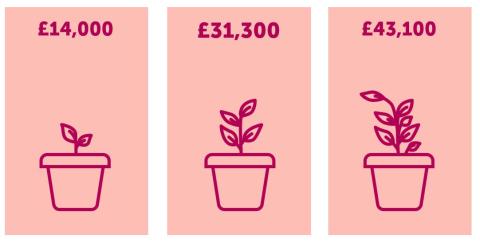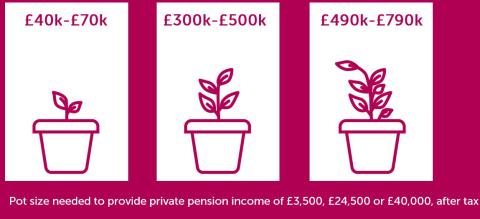Pensions can help you save towards retirement, but it’s not always clear how much you should aim for. In this article, we’ll give you some tips and tools to work out how much your retirement might cost each year, and how much you’ll need in a pension to get it.
What will my retirement cost?
This figure will be personal to you but it can be tricky to pin down. To get started, you could simply assume you’ll need a fraction of what you spend now. If you want to drill down a bit further into the detail you could look at different pockets of spending that might fall away in retirement (e.g. commuting or childcare), or any ‘red lines’ you’ll have, like not cutting down on holidays or eating out.
Handy figures from the Pensions and Lifetime Savings Association (or PLSA for short) can also help. They put a cost on what three different lifestyles might cost in retirement, from a basic ‘minimum’ covering just the essentials, to ‘moderate’ and ‘comfortable’.
You can read about what’s included in the PLSA figures here, but it’s worth pointing out that all three measures have no rental or mortgage costs and they’re all in today’s money - which means they take inflation into account.
These are the yearly incomes according to the PLSA for a single person living outside of London.

Source: PLSA. More figures available at www.retirementlivingstandards.org.uk
What varies between them is the amount assumed to be spent on food, clothing and leisure costs. For example, the minimum living standard assumes one weeklong UK holiday per year which might not tally with what you want. At the other end, the comfortable living standard budgets for a fortnight 4* holiday in the Mediterranean with spending money and three long weekend breaks in the UK. You might find that your preferences are in the middle of two of the standards for lots of the assumptions, but they’re a great place to start.
So how do I get there?
If you’ve got an idea of the income you’d like, there are three main things to think about next.
- The State pension. It currently kicks in at age 66 and assuming you’re eligible for the amount, you’d get £11,500 a year today. So whilst this could be a decent source of income, it won’t cover the cost of the bare essentials. You might also want to start winding down your work before you reach state pension age, which is also due to gradually rise to 67 from May 2026.
- To supplement your state pension, you’ll need to turn to your own savings and investments. There’s no single right way, but most people turn to a pension when saving for retirement due to the generous tax reliefs on what you pay in and that for employed people, your employer will pay in too. Find out more about personal pensions.
- You’ll also need to have an eye on tax – because what counts is what you get in your pocket to spend, which will be after any income tax.
Crunching the numbers, you’ll need to generate an extra income from your own pensions of around £3,500, £24,500 and £40,000 after tax to achieve each of the PLSA living standards. This roughly translates to the following pot sizes at state pension age.
Minimum | Moderate | Comfortable |
|---|

You’ll notice that these pot sizes vary. They are projections after all, and there are a few different at factors at play when you come to access a pension.
There’s the type of pension you have – here we’ve assumed you’ll be growing a pension pot rather than getting an older style ‘final salary’ style scheme. With pension pots like personal pensions or SIPPs, the income you’ll get could vary depending on your health and circumstances at the time – another reason why we’ve had to give a wider range.
And although we’ve crunched the numbers looking at the picture for an individual, if you’re in a couple and able to pool resources, you should be able to attain the living standards at lower cost per person. The good news is that would mean a lower combined pension pot size.
Am I on track?
If you’re employed, thanks to auto-enrolment (and assuming you’re 22 or over and earning more than £10,000), you should get a minimum of 8% of your earnings1 paid into a workplace pension, with at least 3% of that coming from your employer. Auto-enrolment has been great for getting more people saving into a pension, but those minimum levels are unlikely to get you to a substantial pot at retirement on their own as the examples below show.
1*Jargon buster* – the official name is ‘qualifying earnings’. They’re what you earn between a minimum and maximum amount set by the government, rather than your whole salary. Some employers might pay in more than the minimum into a pension for you.
| A 22-year-old earning £27,000 per year, with 8% of their salary paid into a workplace pension (3% coming from their employer), could achieve a pot of around £160,000. | A 30-year-old earning £38,000 with a workplace pot already worth £15,000 could get closer to £200,000, based on the same contribution rates. | A 40-year-old earning £45,000 with a workplace pot already worth £40,000 could get closer to £215,000, based on the same contribution rates. |
Examples illustrate potential total workplace pensions savings built up by State Pension age. Assumes no career breaks, annual investment growth of 5%, salary growth of 3% and inflation of 2.5%.
So we’ve broken down what pot sizes you’d need at certain ages to be on track for that ‘moderate’ living standard in retirement from the PLSA. We’ve used a final pot value of £400,000 (in today’s money) at state pension age, which is in the middle of the range of pot values for that standard.
We’ve also assumed higher contribution rates than the workplace minimum, with 6% from you, matched with 6% from your employer.
| Age now | Current salary | Current pot value needed |
|---|---|---|
| 40 | £45,000 | £100,000 |
| 50 | £50,000 | £200,000 |
| 60 | £50,000 | £300,000 |
Examples illustrate potential total workplace pensions savings built up by State Pension age. Assumes no career breaks, annual investment growth of 5%, salary growth of 3% and inflation of 2.5%.
Where do I start?
The first step is to find out where your pensions currently are; if you have changed job a few times, you may have workplace pensions with different providers, and perhaps one or two you’ve lost in life-admin. Consider bringing them all under one roof but be sure to check if you’d lose any benefits before transferring them into one pot.
Pension calculators can give you a rough picture of what retirement could look like, and the Money Helper calculators are a good resource. With tools to project income and break down workplace pensions, you can enter your current contributions to forecast what your pension could look like when you retire.
In the meantime, take a look at the PLSA link to determine which of the three lifestyles you’re expecting in retirement, and remember, it’s entirely personal preference.
Take a look at our previous Money Matters articles, covering retirement, investing, and managing personal finances to build your knowledge on planning for the long-term. The Money Matters team is here to help you feel good, investing.
These articles are for information purposes only and are not a personal recommendation.




